Introduction to oracle functions
- 1. Introduction to Oracle Functions and Group By Clause
- 2. Introduction to Oracle Functions Functions make the result of the query easier and are used to manipulate the data values. Functions can accept any number of constant values or variables. These variables or constant are called as arguments. SQL functions can perform different types of operations such as modify individual data items, convert column data types, format dates and numbers etc.
- 3. Categories of Functions Oracle functions are categorized into two categories: • Single Row/Scalar Functions • Group/Aggregate Functions Functions, which operate on single rows and return one value per row, are called as Scalar functions or Single Row Functions. On the other hand functions, which operate on set of values to give one result, are called as Group Functions or Aggregate Functions.
- 4. Single-Row Functions (Scalar functions) These functions act on each row of the table and return a single value for each row selected. These functions may accept one or more arguments and can return a value of different data type than that it has accepted.
- 5. Classification of Single Row Functions Single Row Functions can be classified into the following categories: (i) Character (ii) Number (iii) Date (iv) Conversion (v) General
- 8. • length(x) It returns the length of the string x. Example: SQL> Select LENGTH ('Ipso Facto') ergo FROM dual;
- 9. • ltrim(string[,char(s)]) It removes all the blank spaces from the left side of the string if no char is specified. If we give a char, then it removes the leading occurrences of that character from the string.
- 15. • Translate(char,find,new) This function is used to find a char and replace it with new character. All occurrences of find are replaced by the character in new.
- 19. • floor(x) Where x is a number. This function returns the largest integer that is less than or equal to n. FLOOR round down to a whole number.
- 20. • round(x[,y]) It rounds off x to the decimal precision of y. If y is negative, rounds to the precision of y places to the left of the decimal point.
- 21. • sqrt(x) This function returns the square root of the given number x. If the given number x is negative or NULL then the result is NULL. Example: SQL>select sqrt(36) as square_root from dual;
- 22. Date Functions
- 27. SQL> SELECT TO_CHAR(SYSDATE,'HH') HOUR, TO_CHAR(SYSDATE,'MI') MIN,TO_CHAR(SYSDATE,'SS') SEC FROM DUAL; The output is: HO MI SE -- -- -- 03 01 16 SQL> SELECT TO_DATE('15-MAR-1999','DD-MON-YYYY') FROM DUAL; SQL>SELECT TO_NUMBER('49583') FROM DUAL;
- 28. General functions SQL>Select greatest(-2 ,10,’7’) from dual ; SQL>Select least(‘ABCD’,‘abcd’,’xyz’)from dual ;
- 30. SQL>Select user from dual;
- 31. Aggregate Functions (Group Functions) These functions are used to produce summarized results. They are applied on set of rows to give you single value as a result. A group function allows you to perform a data operation on several values in a column of data as though the column was one collective group of data. These functions are called group functions also, because they are often used in a special clause of select statements called a group by clause.
- 32. COUNT (x) This function returns the number of rows or non-null values for column x. When we use * in place of x, it returns the total number of rows in the table. Syntax: count([distinct|all]column name) Example: 1. Count the number of employees in the emp table. SQL>Select count(empno) from emp; The Output is: COUNT(EMPNO) ------------ 16
- 33. List the number of different names in the emp table. SQL>Select count (distinct ename) from emp; The output is: COUNT(DISTINCTENAME) -------------------- 16 List the number of departments in the employee table . SQL>Select count( distinct deptno) from emp; The output is: COUNT(DISTINCTDEPTNO) --------------------- 3
- 34. SUM(x) This function returns the sum of values for the column x. This function is applied on columns having numeric datatype and it returns the numeric value. syntax : sum([distinct|all]column name) Example: List the total salary paid to the employees in the emp table. SQL>select sum(sal) from emp ; The output is: SUM(SAL) --------- 29025
- 35. AVG(x) This function returns the average of values for the column x. This function is applied on columns having numeric datatype and it returns the numeric value. It ignores the null values in the column x. syntax : avg([distinct|all]column name) Example: List the average salary and the number of employees in the emp table . SQL>select avg(sal) ,count(sal) from emp ;
- 36. MIN(x) This function returns the minimum of values for the column x for all the rows .this function can be applied on any datatype . syntax : min([distinct|all]column name) Example: List the minimum salary in the emp table . SQL>select min(sal) from emp ; The output is: MIN(SAL) -------- 800
- 37. MAX(x) This function returns the maximum of values for the column x for all the rows .this function can be applied on any datatype. syntax : max([distinct|all]column name) Example: List the maximum salary and commission in the emp table . SQL>select max(sal) ,max(comm) from emp ;
- 38. Note : The avg() and sum() functions will always be applied on numeric datatype while min() and max() functions can be applied on any datatype. Example SQL>select avg(sal),sum(sal),min(ename),max(ename) from emp ;
- 39. Exercise : •list the names of the employees earning minimum salary . •list the names of the employees earning second highest salary . •list the details of the employees who earn salary greater than the average salary . also count their number . •count the number of employees whose salary is equal to the highest salary . •list the number of employees ,their average salary ,minimum salary and maximum salary in the employee table.
- 40. Grouping Data with GROUP BY GROUP BY clause is used to group or categorize the data. In other words it divide rows in a table into smaller groups. We can then use the group functions to return summary information for each group. If no GROUP BY clause is specified, then the default grouping is the entire result set. When the query executes and the data is fetched, it is grouped based on the GROUP BY clause and the group function is applied.
- 41. Syntax: SELECT column,group_function(column) FROM table [WHERE condition] [GROUP BY group_by_expression] [ORDER BY column]; Here, group_by_expression specifies columns whose values determine the basis for grouping rows.
- 42. For example, If we have to find the total salary of each department manually, first we group the records on the basis of department number and then we apply the sum function on salary of each group to obtain the required result. Similarly in SQL we apply the GROUP BY clause on deptno and then calculate the total salary for each group by Sum(sal) function as shown below: SQL>SELECT deptno, Sum(sal) FROM emp GROUP BY deptno; The output is: DEPTNO SUM(SAL) 10 2916.6667 20 2175 30 1566.6667
- 44. Here is how this SELECT statement, containing a GROUP BY clause, is evaluated: • The SELECT clause specifies the columns to be retrieved i.e Department number column in the EMP table, the sum of all the salaries in the group you specified in the GROUP By clause • The FROM clause specifies the tables that the database must access i.e EMP table. • The WHERE clause specifies the rows to be retrieved. Since there is no WHRE clause, by default all rows are retrieved.
- 45. The GROUP BY clause specifies how the rows should be grouped. Department number groups the rows, so the AVG function that is being applied to the salary column will calculate the average salary for each department. • List the average salary of each job in the emp table. SQL>SELECT JOB,AVG(SAL) FROM EMP GROUP BY JOB; • List the maximum salary for each dept. SQL>SELECT DEPTNO,MAX(SAL) FROM EMP GROUP BY DEPTNO;
- 46. Grouping by more than one column Sometimes there is a need to see results for groups within groups. For example if we have to find the total salary being paid to each job title, within each department. Then there is a need to having grouping on department number and within each department number grouping on the basis of job or in other words there is a need for grouping within a group. Thus, the EMP table is grouped first by department number, and within that grouping, it is grouped by job title. For example, the two clerks in department 20 are grouped together and a single result (total salary) is produced for all clerks people within that group.
- 47. SQL> SELECT deptno,job,sum(sal) FROM emp GROUP BY deptno, job; The output is:
- 49. By above example it is clear that we can return summary results for groups and subgroups by listing more than one GROUP BY column. We can determine the default sort order of the results by the order of the columns in the GROUP BY clause. The SELECT clause specifies the column to be retrieved: • Department number in the EMP table • Job title in the EMP table • The sum of all the salaries in the group that you specified in the GROUP BY clause • The FROM clause specifies the tables that the database must access the EMP table • The GROUP BY clause specifies how we must group the rows First, department number groups the rows. Second, within the department number groups, the rows are grouped by job title. So, the SUM function is being applied to the salary column for all job titles within each department number group.
- 50. Illegal Queries Using Group Functions Whenever you use a mixture of individual items (DEPTNO) and group functions (COUNT) in the same select statement, you must include a Group By clause that specifies the individual items (in this case, DEPTNO). If the GROUP By clause is missing, then the error message “not a single-group group function” appears and an asterisk (*) points to the offending column. You can correct the error by adding the GROUP BY clause.
- 51. For example, following is the illegal query: SQL> SELECT deptno, COUNT(ename) FROM emp; The Output will be: Column missing in the Group By clause Select deptno,count(ename) * ERROR at line 1: ORA-00937: not a single-group group function In above select statement individual items DEPTNO and group function COUNT appears in the same SELECT statement without GROUP BY clause which results error, it can be corrected by adding the GROUP BY clause as shown below: SQL> SELECT deptno,COUNT(ename) FROM emp Group By deptno;
- 52. DEPTNO COUNT(ENAME) 10 3 20 5 30 6 Note: Any column or expression in the SELECT list that is not an aggregate function must be in the GROUP By clause.
- 53. Restricting Group Results As we use the WHERE clause to restrict the rows that we select, we can use the HAVING clause to restrict groups. For example: To find the maximum salary of each department, but show only the departments that have a maximum salary of more than Rs.2900, we need to do the following. • Find the maximum salary for each department by grouping by department number. • Restrict the groups to those departments with a maximum salary greater the Rs.2900.
- 54. Syntax: SELECT column, group_function FROM table {WHERE condition] [GROUP BY group_by_expression] [HAVING group_condition] [ORDER BY Column];
- 55. Here we use the HAVING clause to specify which groups are to be displayed. Therefore, we further restrict the groups on the basis of aggregate information. In the syntax: HAVING clause restricts the groups of rows returned to those groups for which the specified condition is TRUE The Oracle Server performs the following steps when you use the HAVING clause:
- 56. • Rows are grouped • The group function is applied to the group. • The groups that match the criteria in the HAVING clause are displayed. The HAVING clause can precede the GROUP By clause, but it is recommended that you place the GROUP By clause first because it is more logical. Groups are formed and group functions are calculated before the HAVING clause is applied to the groups in the SELECT list.
- 57. For example: To find the maximum salary of each department, but show only the departments that have a maximum salary of more than Rs.2900 SQL> SELECT deptno,max(sal) FROM emp GROUP BY deptno Having max(sal)>2900; The output is: DEPTNO MAX(SAL) 10 5000 20 3000
- 58. Use of WHERE clause with GROUP BY clause List the total salary, maximum and minimum salary and the average salary of employees job wise, for department number 20 and display only those rows having average salary greater than 1000 SQL>SELECT job, SUM(sal), avg(sal), max(sal), min(sal) from emp WHERE deptno=20 GROUP by job HAVING AVG(sal)>1000;
- 59. The output is: JOB SUM(SAL) AVG(SAL) MAX(SAL) MIN(SAL) ANALYST 6000 3000 3000 3000 MANAGER 2975 2975 2975 2975
- 60. SQL> SELECT job, SUM(sal) PAYROLL FROM emp WHERE job NOT LIKE 'SALE%' GROUP BY job HAVING SUM(sal)>5000 ORDER BY SUM(sal); The output is: JOB PAYROLL ANALYST 6000 MANAGER 8275 The above query displays the job title and total monthly salary for each job title with a total payroll exceeding Rs.5000. The example excludes salespeople and sorts the list by the total monthly salary.
- 61. Display total no of suppliers supplying red part Display total qty supplied by by each supplier Display total Qty supplied for each part excluding P3 Only display those where supplied qty is greater than100 Display info in descending order of Qty Select Pno, Sum(QTY) from P,SP WHERE PNO<>’P3’ GROUP BY PNO HAVING SUM(QTY)>1000 ORDER BY PNO;
- 62. Display total Qty supplied for each part excluding part having red color, Only display those where supplied qty is greater than100 Select Pno, Sum(QTY) from P,SP WHERE PNO NOT IN(SELECT PNO FROM P WHERE COLOR=‘RED’) GROUP BY PNO HAVING SUM(QTY)>1000 ORDER BY PNO;


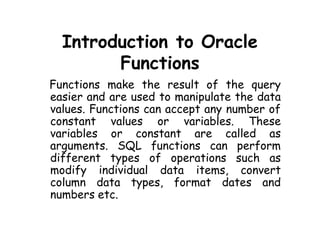

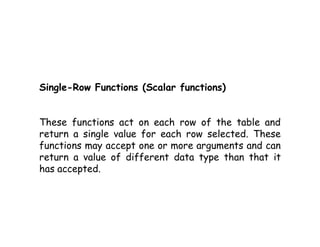




![• ltrim(string[,char(s)])
It removes all the blank spaces from the left side of the
string if no char is specified. If we give a char, then it
removes the leading occurrences of that character from the
string.](https://image.slidesharecdn.com/introductiontooraclefunctions-140919120210-phpapp02/85/Introduction-to-oracle-functions-9-320.jpg)





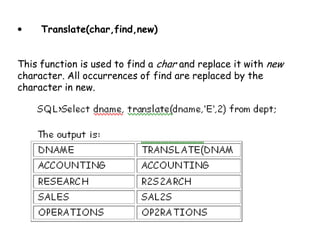




![• round(x[,y])
It rounds off x to the decimal precision of y. If y is negative, rounds to the precision of y places to the left of the
decimal point.](https://image.slidesharecdn.com/introductiontooraclefunctions-140919120210-phpapp02/85/Introduction-to-oracle-functions-20-320.jpg)

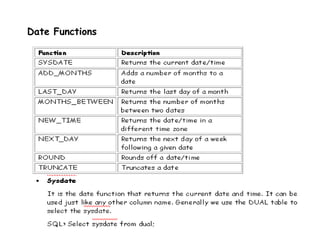









![COUNT (x)
This function returns the number of rows or non-null values
for column x. When we use * in place of x, it returns the
total number of rows in the table.
Syntax:
count([distinct|all]column name)
Example:
1. Count the number of employees in the emp table.
SQL>Select count(empno) from emp;
The Output is:
COUNT(EMPNO)
------------
16](https://image.slidesharecdn.com/introductiontooraclefunctions-140919120210-phpapp02/85/Introduction-to-oracle-functions-32-320.jpg)

![SUM(x)
This function returns the sum of values for the
column x. This function is applied on columns having numeric
datatype and it returns the numeric value.
syntax : sum([distinct|all]column name)
Example:
List the total salary paid to the employees in the emp table.
SQL>select sum(sal) from emp ;
The output is:
SUM(SAL)
---------
29025](https://image.slidesharecdn.com/introductiontooraclefunctions-140919120210-phpapp02/85/Introduction-to-oracle-functions-34-320.jpg)
![AVG(x)
This function returns the average of values for
the column x. This function is applied on columns having
numeric datatype and it returns the numeric value. It ignores
the null values in the column x.
syntax : avg([distinct|all]column name)
Example:
List the average salary and the number of employees in the
emp table .
SQL>select avg(sal) ,count(sal) from emp ;](https://image.slidesharecdn.com/introductiontooraclefunctions-140919120210-phpapp02/85/Introduction-to-oracle-functions-35-320.jpg)
![MIN(x)
This function returns the minimum of values for the column
x for all the rows .this function can be applied on any
datatype .
syntax : min([distinct|all]column name)
Example:
List the minimum salary in the emp table .
SQL>select min(sal) from emp ;
The output is:
MIN(SAL)
--------
800](https://image.slidesharecdn.com/introductiontooraclefunctions-140919120210-phpapp02/85/Introduction-to-oracle-functions-36-320.jpg)
![MAX(x)
This function returns the maximum of values for
the column x for all the rows .this function can be applied on
any datatype.
syntax : max([distinct|all]column name)
Example:
List the maximum salary and commission in the emp table .
SQL>select max(sal) ,max(comm) from emp ;](https://image.slidesharecdn.com/introductiontooraclefunctions-140919120210-phpapp02/85/Introduction-to-oracle-functions-37-320.jpg)



![Syntax:
SELECT column,group_function(column) FROM table
[WHERE condition]
[GROUP BY group_by_expression]
[ORDER BY column];
Here, group_by_expression specifies columns whose values
determine the basis for grouping rows.](https://image.slidesharecdn.com/introductiontooraclefunctions-140919120210-phpapp02/85/Introduction-to-oracle-functions-41-320.jpg)









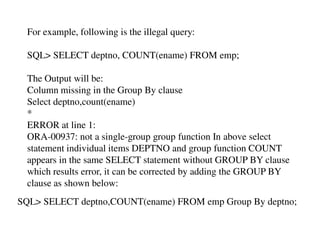


![Syntax:
SELECT column, group_function
FROM table
{WHERE condition]
[GROUP BY group_by_expression]
[HAVING group_condition]
[ORDER BY Column];](https://image.slidesharecdn.com/introductiontooraclefunctions-140919120210-phpapp02/85/Introduction-to-oracle-functions-54-320.jpg)







